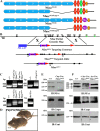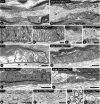In vivo deletion of immunoglobulin domains 5 and 6 in neurofascin (Nfasc) reveals domain-specific requirements in myelinated axons
- PMID: 20371806
- PMCID: PMC2856701
- DOI: 10.1523/JNEUROSCI.5951-09.2010
In vivo deletion of immunoglobulin domains 5 and 6 in neurofascin (Nfasc) reveals domain-specific requirements in myelinated axons
Abstract
The formation of paranodal axo-glial junctions is critical for the rapid and efficient propagation of nerve impulses. Genetic ablation of genes encoding the critical paranodal proteins Caspr, contactin (Cont), and the myelinating glia-specific isoform of Neurofascin (Nfasc(NF155)) results in the disruption of the paranodal axo-glial junctions, loss of ion channel segregation, and impaired nerve conduction, but the mechanisms regulating their interactions remain elusive. Here, we report that loss of immunoglobulin (Ig) domains 5 and 6 in Nfasc(NF155) in mice phenocopies complete ablation of Nfasc(NF155). The mutant mice lack paranodal septate junctions, resulting in the diffusion of Caspr and Cont from the paranodes, and redistribution of the juxtaparanodal potassium channels toward the nodes. Although critical for Nfasc(NF155) function, we find that Ig5-6 are dispensable for nodal Nfasc(NF186) function. Moreover, in vitro binding assays using Ig5-6 deletion constructs reveal their importance for the association of Nfasc(NF155) with Cont. These findings provide the first molecular evidence demonstrating domain-specific requirements controlling the association of the paranodal tripartite complex in vivo. Our studies further emphasize that in vivo structure/function analysis is necessary to define the unique protein-protein interactions that differentially regulate the functions of Neurofascins during axonal domain organization.
Figures




Similar articles
-
Spatiotemporal ablation of myelinating glia-specific neurofascin (Nfasc NF155) in mice reveals gradual loss of paranodal axoglial junctions and concomitant disorganization of axonal domains.J Neurosci Res. 2009 Jun;87(8):1773-93. doi: 10.1002/jnr.22015. J Neurosci Res. 2009. PMID: 19185024 Free PMC article.
-
Neurofascins are required to establish axonal domains for saltatory conduction.Neuron. 2005 Dec 8;48(5):737-42. doi: 10.1016/j.neuron.2005.10.019. Neuron. 2005. PMID: 16337912
-
Neurofascin is a glial receptor for the paranodin/Caspr-contactin axonal complex at the axoglial junction.Curr Biol. 2002 Feb 5;12(3):217-20. doi: 10.1016/s0960-9822(01)00680-7. Curr Biol. 2002. PMID: 11839274
-
Molecular organization and function of vertebrate septate-like junctions.Biochim Biophys Acta Biomembr. 2020 May 1;1862(5):183211. doi: 10.1016/j.bbamem.2020.183211. Epub 2020 Feb 4. Biochim Biophys Acta Biomembr. 2020. PMID: 32032590 Review.
-
A molecular view on paranodal junctions of myelinated fibers.J Physiol Paris. 2002 Jan-Mar;96(1-2):99-103. doi: 10.1016/s0928-4257(01)00085-7. J Physiol Paris. 2002. PMID: 11755788 Review.
Cited by
-
Gene and protein expression profiles of olfactory ensheathing cells from olfactory bulb versus olfactory mucosa.Neural Regen Res. 2022 Feb;17(2):440-449. doi: 10.4103/1673-5374.317986. Neural Regen Res. 2022. PMID: 34269221 Free PMC article.
-
Down Syndrome Developmental Brain Transcriptome Reveals Defective Oligodendrocyte Differentiation and Myelination.Neuron. 2016 Mar 16;89(6):1208-1222. doi: 10.1016/j.neuron.2016.01.042. Epub 2016 Feb 25. Neuron. 2016. PMID: 26924435 Free PMC article.
-
Anti-pan-neurofascin antibodies induce subclass-related complement activation and nodo-paranodal damage.Brain. 2023 May 2;146(5):1932-1949. doi: 10.1093/brain/awac418. Brain. 2023. PMID: 36346134 Free PMC article.
-
Fibronectin type III-like domains of neurofascin-186 protein mediate gliomedin binding and its clustering at the developing nodes of Ranvier.J Biol Chem. 2011 Dec 9;286(49):42426-42434. doi: 10.1074/jbc.M111.266353. Epub 2011 Oct 17. J Biol Chem. 2011. PMID: 22009740 Free PMC article.
-
Whirlin, a cytoskeletal scaffolding protein, stabilizes the paranodal region and axonal cytoskeleton in myelinated axons.BMC Neurosci. 2013 Sep 6;14:96. doi: 10.1186/1471-2202-14-96. BMC Neurosci. 2013. PMID: 24011083 Free PMC article.
References
-
- Bhat MA, Rios JC, Lu Y, Garcia-Fresco GP, Ching W, St Martin M, Li J, Einheber S, Chesler M, Rosenbluth J, Salzer JL, Bellen HJ. Axon-glia interactions and the domain organization of myelinated axons requires neurexin IV/Caspr/Paranodin. Neuron. 2001;30:369–383. - PubMed
-
- Boyle ME, Berglund EO, Murai KK, Weber L, Peles E, Ranscht B. Contactin orchestrates assembly of the septate-like junctions at the paranode in myelinated peripheral nerve. Neuron. 2001;30:385–397. - PubMed
-
- Charles P, Tait S, Faivre-Sarrailh C, Barbin G, Gunn-Moore F, Denisenko-Nehrbass N, Guennoc AM, Girault JA, Brophy PJ, Lubetzki C. Neurofascin is a glial receptor for the paranodin/Caspr-contactin axonal complex at the axoglial junction. Curr Biol. 2002;12:217–220. - PubMed
Publication types
MeSH terms
Substances
Grants and funding
LinkOut - more resources
Full Text Sources
Molecular Biology Databases
